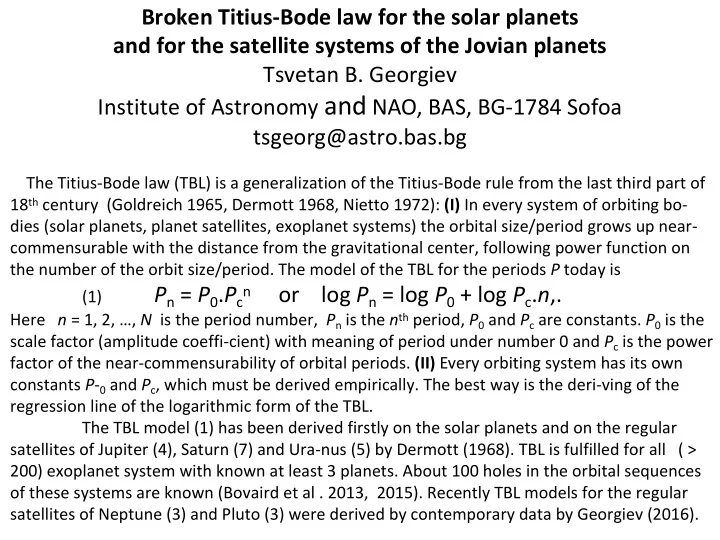

Broken Titius-Bode law for the solar planets and for the satellite systems of the Jovian planets Tsvetan B. Georgiev Institute of Astronomy and NAO, BAS, BG-1784 Sofoa tsgeorg@astro.bas.bg The Titius-Bode law (TBL) is a generalization of the Titius-Bode rule from the last third part of 18 th century (Goldreich 1965, Dermott 1968, Nietto 1972): (I) In every system of orbiting bo- dies (solar planets, planet satellites, exoplanet systems) the orbital size/period grows up near- commensurable with the distance from the gravitational center, following power function on the number of the orbit size/period. The model of the TBL for the periods P today is P n = P 0 . P cn or log P n = log P 0 + log P c . n ,. (1) Here n = 1, 2, …, N is the period number, P n is the n th period, P 0 and P c are constants. P 0 is the scale factor (amplitude coeffi-cient) with meaning of period under number 0 and P c is the power factor of the near-commensurability of orbital periods. (II) Every orbiting system has its own constants Р - 0 and Р с , which must be derived empirically. The best way is the deri-ving of the regression line of the logarithmic form of the TBL. The TBL model (1) has been derived firstly on the solar planets and on the regular satellites of Jupiter (4), Saturn (7) and Ura-nus (5) by Dermott (1968). TBL is fulfilled for all ( > 200) exoplanet system with known at least 3 planets. About 100 holes in the orbital sequences of these systems are known (Bovaird et al . 2013, 2015). Recently TBL models for the regular satellites of Neptune (3) and Pluto (3) were derived by contemporary data by Georgiev (2016).
Meaning of the TBL : When the distance from the Sun increases the orbits become rarefied as approximate power function A n = A o .A cn or P n = P o .P cn with coefficient of regularity A o ≈1.9 или P o ≈2.6; In the cases of guitar, mandolin, etc., with 12 halftone positions in the frames of one octave, the coefficient is just A o = 2 1/12 ≈ 1.06. 2
TBLs of S. Dermott (1969, MNRAS) for the satellites of Jupiter, Saturn and Uranus. Relative deviations ε10-15 %. The Problem was : Whether the gradient of the TBL depends on the fundamental parameters of the system such as the mass of the central body and total mass of the orbtal bodies 3
TBLs for the Terrestrial planets and 4 exoplanet systems; The known exoplanet systems have very short sizes! General TBL of 20+1 objects in the the Solar system, up to hypotetic Planet 9, ε = 24%; The Earth and Neptune are irrelevant s! 4
Optimal numbering: TBL model: lgP N = lgP 0 + lgP C ×N ↔ Q N = Q 0 + Q C ×N Numbering: N(Q C ) = (int) [(Q N –Q 1 )/Q C ]; MLS: <Q N > = A× N(Q C ) + B; Error function: E(Q C )= Σ(Q N - <Q N >>) 2 ; → Q C1 , Q C2 & N(Q C1 ), N(Q C2 ) Example: Solar system with 6 regular planets (without the Earth & Neptune) s(logP) = 7%; Qc=G=logPc= 0.42; Pc=2.64; Ac = 1.91 5
55 Canceri with 5 exoplanets , 3 our models М0, М1 и М2 and models of Poveda & Lara (208) L1 and Bobaird & Lineweaver (2013-15) L2. Comparison: (0) The gradiants are close to these of SS; (I) The size is ~ Jupiter orbit, 4 times less than Uranus orbit; (II) The planets are giants; (IV) The rotational period of the star does not support the TBL. Parameters of the TBL: G 1 =logPc(M 1 ), G 2 =logPc(M 2 ), logS = log(M/N) 6
7
8
9
Common dependence of the TBR gradient G on the mass of the central body, log M 0 . The dependence is valid over more than 8 deca-magnitudes of $M_0$ (Georgiev 2018). Generally, the gradient G and the separability S of the TBL model depend mainly on the total mass of the orbiting bodies Mo, but this mass in the exoplanet systems correlates well with the metallicity of the star. 10
Unique large dependence, log M S -- G, covering systems of planets, systems of regular moons of Jovian planets plus Pluto, and systems of small inner satellites of the Jovian Planets. The dependence is fitted by 3-rd order polynomial over 10 deca-magnitudes of M S (Georgiev, 2018). (Faber-Jackson relation – 16 stellar mags = 16/2.5 = 6 deca-mags.) 11
Solar System – 2 planetary populations – 2 TBLs Left panel: Under classic numberings, without rotational period od the Sun; T he TBL seems to be broken. Right panel: Under optimal numberings, with use of the rotational period of the Sun under No.=0; T he TBL seems to be duallistic. 12
Broken TBLs for the satellite systems of the Jovian Planets (Pc ~ 1.05) 13
Main results 1. TBL in the SS is broken with 2 well pronounced parts (with low ε). 2. The TBL models for the regular satellites of Jupiter, Saturn and Uranus predict well the rotational periods of the planets under No.0. However, the expected rotational period of Neptune is about 1,5 times less than the observing 3. In 3 cases the planetary rings cover the rotational period of the planet plus numbers of missing small inner satellites = at Jupiter No.10, at Saturn No.0 & No.1 and at Neptune No.0 . However, the ring of Uranus Does not envelop the rotational period of the planet and occurs even below the known small satellites. It may be associated with missing satellite No,6 14
Recommend
More recommend